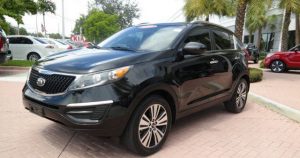 Often cars are compared side by side with numbers and statistics. In this article, you will see the basic version of what these numbers mean when you put them all together. The Kia Sportage and the Hyundai Tucson come from the same parent company. They are well-rated vehicles. While they offer similar packaging, the subtle differences add up to an increase or decrease in your contentment level when exploring the roads in your new wheels. Read on to get a layman’s breakdown of the vehicles and decide which choice buys you the best vehicle.
Often cars are compared side by side with numbers and statistics. In this article, you will see the basic version of what these numbers mean when you put them all together. The Kia Sportage and the Hyundai Tucson come from the same parent company. They are well-rated vehicles. While they offer similar packaging, the subtle differences add up to an increase or decrease in your contentment level when exploring the roads in your new wheels. Read on to get a layman’s breakdown of the vehicles and decide which choice buys you the best vehicle.
MSRP and Commonalities
The Kia Sportage’s starting MSRP is $22,150, which is $550 less than the Hyundai Tucson. The two sport utility vehicles have divided rear seats that fold down to maximize storage space. They come in all-wheel or two-wheel drive, boast impressive safety ratings, and offer convenient upgrades like navigation systems with top-of–the-line audio and speakers. Sleek, aerodynamic designs make up their exteriors.
Cylinders and Engine Size
Gasoline burns in the cylinders to give a car the gusto to keep moving. Because the cylinders house the power, more is better, but fuel efficiency usually suffers as the number of barrels increases. Both vehicles contain four-cylinder engines. The Tucson beats the Kia by three miles per gallon in fuel optimization, but that concerns the displacement, or volume, of the motor. Engine size is much like cylinders — higher numbers mean more power but reduced miles per gallon. The Kia carries a 2.4-liter engine compared to the 2.0-liter engine in the Hyundai. That’s one-fifth bigger.
The Turbocharged Engine
A turbocharger boosts the power of an engine much like a metabolic enhancer jolts your metabolism. Often a four-cylinder feels like a six-cylinder with the turbocharger, but the upside is it uses less gas when driven efficiently. Both higher-end models contain a turbo engine, but the Kia once again carries an engine substantially larger than its counterpart.
Torque and Horsepower
When you push back into the seat while accelerating from a stop, that is torque. Big rigs require torque to initiate movement. Horsepower defines how much continuous work a car can perform. Generally, larger engines produce more torque while smaller engines provide horsepower. A racing car needs good torque to catapult off the starting line and requires horsepower to sustain its speed over the course of the race. The Kia’s turbo engine submerges the competition with 260 horsepower compared to the competition’s 175 horsepower. Its 269 pound-feet of torque boost it past the Tucson’s 195 pound-feet of torque.
While the 2016 Kia Sportage and the 2016 Hyundai Tucson can each stand on their own four wheels, the Hyundai lacks something essential – power. Because the most important part of selecting a car is surveying what’s under the hood, a vote for the Hyundai would act contrary to common sense. The Kia moves quicker and stays at its optimal speed longer than its rival. Since the purpose of a car is to maximize commuting time, select the one that does just that.
Photo by Kia





 Warranties include 10-year/100,000-mile powertrain and 5-year/60,000-mile basic. All warranties and roadside assistance are limited. See retailer for warranty details.
Warranties include 10-year/100,000-mile powertrain and 5-year/60,000-mile basic. All warranties and roadside assistance are limited. See retailer for warranty details.